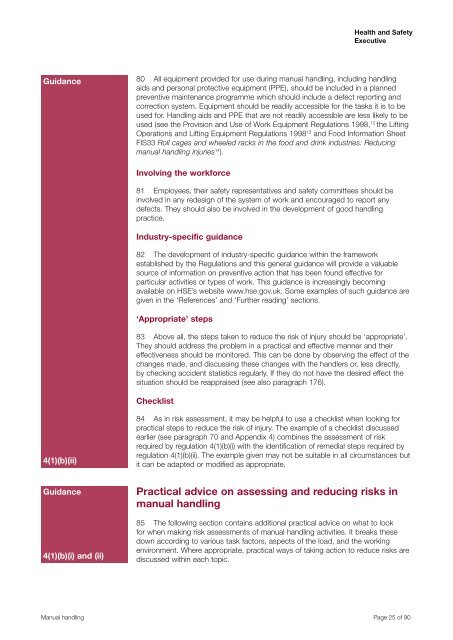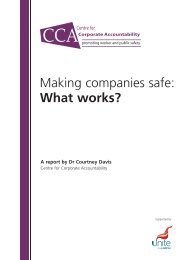Manual Handling Manual Handling Operations Regulations 1992 ...
Manual Handling Manual Handling Operations Regulations 1992 ...
Manual Handling Manual Handling Operations Regulations 1992 ...
You also want an ePaper? Increase the reach of your titles
YUMPU automatically turns print PDFs into web optimized ePapers that Google loves.
Health and Safety<br />
Executive<br />
Guidance<br />
80 All equipment provided for use during manual handling, including handling<br />
aids and personal protective equipment (PPE), should be included in a planned<br />
preventive maintenance programme which should include a defect reporting and<br />
correction system. Equipment should be readily accessible for the tasks it is to be<br />
used for. <strong>Handling</strong> aids and PPE that are not readily accessible are less likely to be<br />
used (see the Provision and Use of Work Equipment <strong>Regulations</strong> 1998, 12 the Lifting<br />
<strong>Operations</strong> and Lifting Equipment <strong>Regulations</strong> 1998 13 and Food Information Sheet<br />
FIS33 Roll cages and wheeled racks in the food and drink industries: Reducing<br />
manual handling injuries 14 ).<br />
Involving the workforce<br />
81 Employees, their safety representatives and safety committees should be<br />
involved in any redesign of the system of work and encouraged to report any<br />
defects. They should also be involved in the development of good handling<br />
practice.<br />
Industry-specific guidance<br />
82 The development of industry-specific guidance within the framework<br />
established by the <strong>Regulations</strong> and this general guidance will provide a valuable<br />
source of information on preventive action that has been found effective for<br />
particular activities or types of work. This guidance is increasingly becoming<br />
available on HSE’s website www.hse.gov.uk. Some examples of such guidance are<br />
given in the ‘References’ and ‘Further reading’ sections.<br />
‘Appropriate’ steps<br />
83 Above all, the steps taken to reduce the risk of injury should be ‘appropriate’.<br />
They should address the problem in a practical and effective manner and their<br />
effectiveness should be monitored. This can be done by observing the effect of the<br />
changes made, and discussing these changes with the handlers or, less directly,<br />
by checking accident statistics regularly. If they do not have the desired effect the<br />
situation should be reappraised (see also paragraph 176).<br />
Checklist<br />
4(1)(b)(ii)<br />
84 As in risk assessment, it may be helpful to use a checklist when looking for<br />
practical steps to reduce the risk of injury. The example of a checklist discussed<br />
earlier (see paragraph 70 and Appendix 4) combines the assessment of risk<br />
required by regulation 4(1)(b)(i) with the identification of remedial steps required by<br />
regulation 4(1)(b)(ii). The example given may not be suitable in all circumstances but<br />
it can be adapted or modified as appropriate.<br />
Guidance<br />
4(1)(b)(i) and (ii)<br />
Practical advice on assessing and reducing risks in<br />
manual handling<br />
85 The following section contains additional practical advice on what to look<br />
for when making risk assessments of manual handling activities. It breaks these<br />
down according to various task factors, aspects of the load, and the working<br />
environment. Where appropriate, practical ways of taking action to reduce risks are<br />
discussed within each topic.<br />
<strong>Manual</strong> handling Page 25 of 90
















